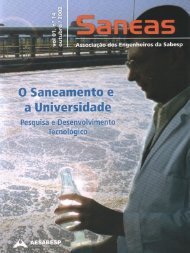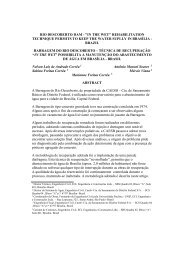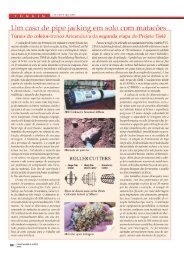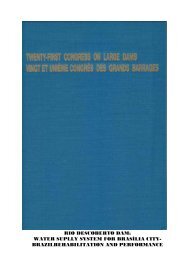USSD Rio Descoberto Dam - Sabino Freitas Correa-ENGL -
22nd US Society of Dams International Meeting Published - Rio Descoberto Dam - Rehabilitation Technique Permits to Keep Water Supply in Brasília - Brazil - Corrêa, Nelson, Corrêa Marianne, Sabino Freitas Correa, Soares,A., Viana,M.
22nd US Society of Dams International Meeting Published - Rio Descoberto Dam - Rehabilitation Technique Permits to Keep Water Supply in Brasília - Brazil - Corrêa, Nelson, Corrêa Marianne, Sabino Freitas Correa, Soares,A., Viana,M.
Create successful ePaper yourself
Turn your PDF publications into a flip-book with our unique Google optimized e-Paper software.
Diaphragm Continuity<br />
The continuity of the diaphragm panels was controlled by mechanical testing and<br />
underwater VHS video system. The mechanical test was made by letting down a steel<br />
plate with the minimum diaphragm thickness allowed. This steel plate was hung by two<br />
ropes, and this procedure was hand made in order to assure the necessary sensitivity. In<br />
case of any kind of obstruction or discontinuity, the plate wouldn’t reach the bottom of the<br />
diaphragm panel. In case of persistence of doubt after the mechanical test, the VHS<br />
underwater camera was used to inspect the suspect drive. This video system was also used<br />
to check and register the contact between different drives.<br />
Mortar Control<br />
Besides the initial analyses done before starting the works, during the project all the mortar<br />
applied was controlled and tested. The controls were made by casting 10 cylindrical<br />
specimens at each truck mixer (6m3 capacity). From those ten specimens, four of them<br />
were experimented at compressive tests at 4-days age, four were tested at 28-days age and<br />
the two remaining were kept tagged with all the data concerning the mortar recorded. The<br />
average compressive strength was 27 MPa. There were also been made 3-day, 7-day, 28-<br />
day and 63-day age testing series.<br />
CONSTRUCTION CHRONOLOGY<br />
The drilling works started in September of 2000 at the block “Q”, this was the first block<br />
finished in 2001 January. The average drilling rate was 5000 meter per month, and the<br />
peak drilling month rate was reached in June of 2001 with 8000 meters drilled in 30 days,<br />
working with five drilling equipments.<br />
Comparative Photos<br />
Figure 5: Construction Chronogram<br />
BEHAVIOR EVALUATIONS






